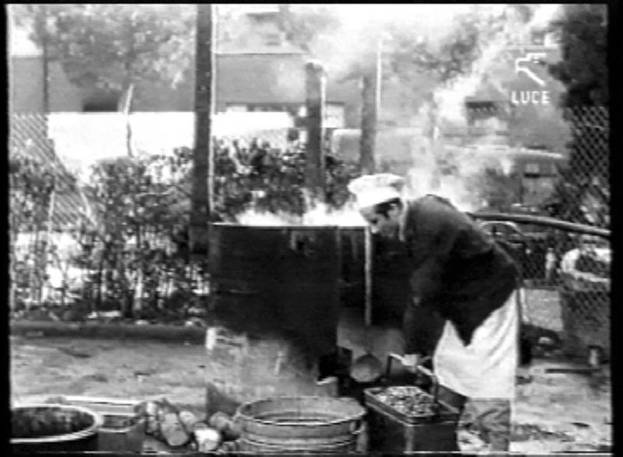


In 1937, Fascist leader Benito Mussolini founded in Rome a movie studio to create propaganda films for his Nazi-sympathizing regime. Cinecittà [2] (‘Film City’) was heavily bombed by the Allies during the war, and afterward, its sound stages were used to house thousands of Italians who had been displaced by the war. Buildings, backdrops and sets – from Roman temples to French boudoirs – were adapted to accommodate the refugees’ most basic needs. One section of the movie complex was run by the Italian Post-war Assistance Ministry, the other half was controlled by the United Nations Relief and Rehabilitation Administration (UNRRA). No matter what side they were living in, life in the camp was extremely hard.
There hardly is any documentation on this topic, but the “Hollywood on the Tiber,” where Audrey Hepburn rode a Vespa scooter in Roman Holiday, Charlton Heston learned to pilot a chariot for Ben-Hur, Elizabeth Taylor and Richard Burton fell in love while making Cleopatra, and Fellini shot La Dolce Vita, his famous film inspired by the glamor of visiting Hollywood stars, housed displaced people of 30 different nationalities, among them Italians, Poles, Russians, Iranians, Chinese, Gypsies and Jews – including survivors of Nazi extermination camps.
In honor of Remembrance Day, the Primo Levi Center in cooperation with Casa Italiana Zerilli-Marimò [3]presented a special screening of The Refugees of Cinecittà a documentary film by Marco Bertozzi, director, writer and film teacher, based on the research by Noa Steimatsky, Associate Professor in the Department of Cinema and Media Studies at the University of Chicago, that “explores the historical conditions at the time of the camp's creation, the magnitude of its population, the duration of its existence and the broader social and political forces that governed its development,” Casa Italiana's promotional material describes..
“Federico Fellini established Cinecittà as his city, and Stage 5 his home,” Cinecitta's web site says.
His La Dolce Vita, which captured the decadence of Rome's cafe society, was shot at Cinecittà's Studio 5, the same sound stage where Fellini shot his other films and where his own wake took place, the same sound stage where Bruna, Flora, Iole, Angelo and many other refugees, when they were young kids, played war with stage props and appeared as extras in propaganda videos and, later on, in film productions (in 1949, MGM [4] filmed the colossal production of Quo Vadis, and among the 14,000 extras that filled the set many were refugees). “They used us because we were real,” one of the the survivors is heard saying, “I never told anyone I was one of the Children of Cinecittà as I was too embarrassed of having been a refuge,” another one adds as their voices overlap while historical images show faces of people they knew... one recognizes his mother, his sister, the boy that ended up marrying his sister, a neighbor in the barricades and so forth.
“My challenge as director of this documentary film was to find harmony between two different types of sources, personal stories from the survivors of the camp and historical (fictional and not) footage,” Bertozzi, present at Casa Italiana, said of his collection of interviews, scenes of films, archival footage and photographs.
Director Marco Bertozzi and film scholar Noa Steimatsky were able to track down several of Cinecittà former refugees as well as “Humanity, the only surviving visual document of post-war life in the ruinous remains of the Fascist propaganda empire. The documentary was shot in 1946 by Jack Salvatori and produced by Luce under the aegis of UNRRA and the Post-War Assistance Ministry. Conceived with narrative simplicity and ideological correctness, the film also contains several high panoramic shots. They reveal thousands of people living inside a hallucinatory labyrinth of roofless boxes, squeezed tightly together among their meager personal belongings, inside massive movie sound stages,” Casa Italiana's material explains.
“A refugee was seen as less than a poor person, because refugees are totally lost, they don't even have a place where they belong. They were more poor than the poor portrayed in Neo-realist films. Women, for example, could not say they had been in the camp, or nobody would have married them, they had to keep it a secret. There was a lot of discrimination, embarrassment,” Bertozzi added.
The feeling among the refugees is different: there are those who want to forget and totally remove those years from their memory, while there is who is using it as inspiration to write books. Memory is never 100% right but they probably all agree with what one of the refugees, Katrin, said in the documentary “it was an experience that ended happily but it was not happy.”
Source URL: http://test.casaitaliananyu.org/magazine/events/reports/article/remembrance-day-special-screening-refugees-cinecitta
Links
[1] http://test.casaitaliananyu.org/files/campoprofughilarge1328126778jpg
[2] http://www.cinecittastudios.it
[3] http://www.casaitaliananyu.org
[4] http://www.mgm.com